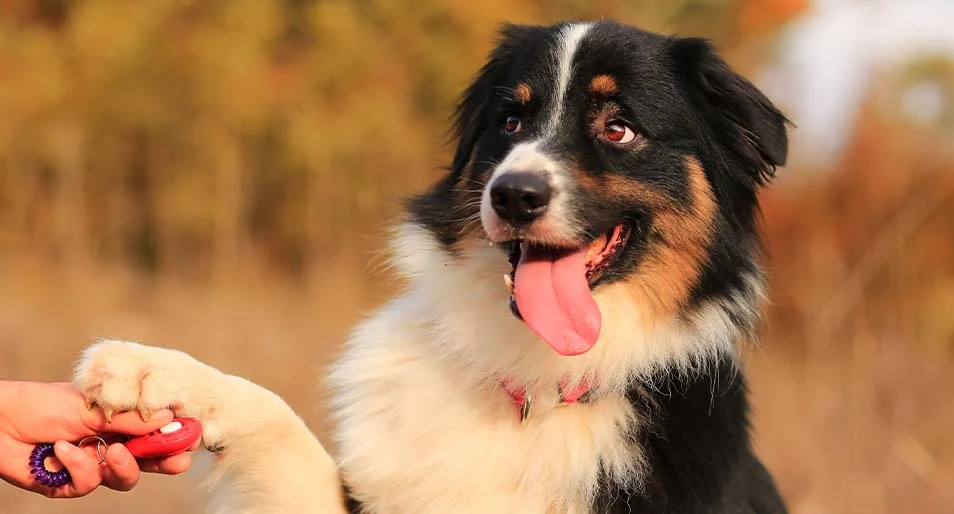PET BEHAVIOR
Ask any dog owner how they would spend three wishes, and most would use at least one to give their pooch the ability to speak. Humans have been trying to understand what our dogs have been saying since the first wild canine laid down by the campfire. But dog behavior doesn’t have to be an enigma! The truth is that our pups are constantly communicating with us. We’re here to help you understand and interpret some common dog behaviors.
Dog Body Language
Aside from barking and whining, dogs are most expressive with their bodies.3 But reading dog body language can be less straightforward than it seems. Even the most energetic pup can have nuance in their expressions. A wagging tail is not always a happy tail.
Dog body language can be broken down into three general categories: the head, the body, and the tail. Dogs use all of them to communicate, so it’s important to understand the vocabulary of each. Here’s a quick chart to reference when trying to discern between happy and stressed dog body language:
Body Language Guide |
Happy |
Stressed |
|---|---|---|
Head |
A happy dog’s eyes will usually be soft with relaxed eyelids. They may also smile by showing their front teeth with relaxed lips. |
Stressed dogs will avoid eye contact by looking away and may also show more of the whites of their eyes than normal. Baring their teeth in a snarl that raises the lips is another clear stress indicator. |
Body |
A happy dog may be wiggly, while a relaxed one will be loose and still. Watch for the “play bow”, when your pup lowers their front and raises their rump. |
Stressed dogs want to make themselves small by getting low to the ground. In some cases they may roll onto their backs and even urinate. |
Tail |
A broad, fully-body wag means your dog is relaxed. |
Twitchy tail movements indicate an alert state. A tail held high can also mean confidence or even aggression. A tucked tail signals stress and submission. |
It’s often the case that no single facet of body language will tell the whole story. For instance, coming home from work to a wagging tail could mean your dog is happy to see you. But, if your dog is also holding themselves low to the ground, that could mean they’re suffering from separation anxiety when you’re away.
Remember, your dog will use their whole body to talk to you, so be sure to listen!
Understanding stressed dog body language
There are many situations that can cause dogs stress, but not all of them may be obvious. Recognizing the signs is an important step in deepening your bond with your pooch. In addition to the body language mentioned above, be on the lookout for:
- Piloerection: Also known as raised hackles, this is an involuntary response, like goosebumps for fur.
- Excessive yawning or lip licking: Dogs do this to calm themselves down.
- Shivering: While there are many reasons why your dog might be trembling, it often manifests when they are uncomfortable. (Note that seizures can also be a sign of a serious medical problem.)
Finally, be sure to pay attention to the environment your dog is in. An old shaking dog may just be experiencing the effects of age. But, if you notice your dog trembling only when around other people, they could be experiencing anxiety triggered by strangers. Recognizing these triggers allows you to take steps to keep your dog calm and avoid unhealthy environments.
The Weird and Wonderful World of Dog Behavior
We may never fully understand why our dogs do what they do. But that doesn’t mean there aren’t answers out there! As a dog parent, you never stop learning the ins and outs of your pup’s personality. You might be surprised just how much their behavior can tell you about their internal life.
So, if you’ve ever wondered:
- Why your dog drinks from the toilet
- Why your dog is eating grass
- Why your dog is licking their bum
- Why your dog gets the “zoomies” at random hours of the day
Then you’re on the right track to becoming an expert dog parent. The more you know about your furry family, the stronger your relationship with them becomes, and the better you’re able to take care of them.
At MetLife, we’re committed to helping you keep your pets happy and healthy, whether that means learning all there is to know about dog behaviors or protecting your pooch with an insurance policy.1 Learn more about how a pet insurance policy can help protect your pup.2

